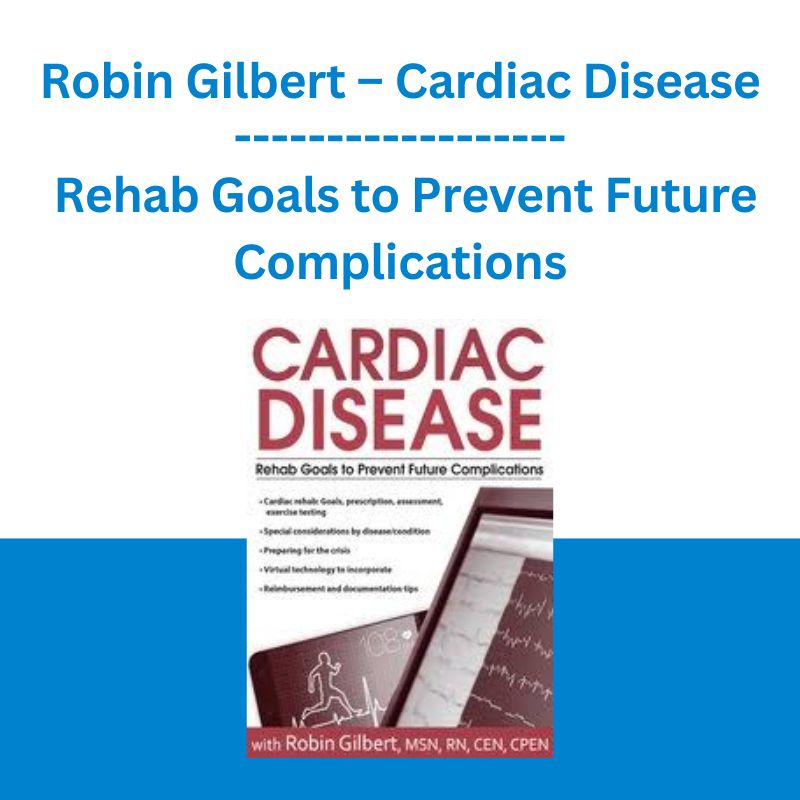*** Proof of Product ***
Exploring the Essential Features of “Robin Gilbert – Cardiac Disease: Rehab Goals to Prevent Future Complications”
Mr. Jones is day 2 on the telemetry unit where he had been admitted following flu symptoms with nausea and vomiting. He was seen by the physician this a.m. and is scheduled for discharge when suddenly his monitor alarms from ventricular fibrillation. What happened? What did we miss?
There has been a paradigm shift in how we care for our cardiac population. In the past, we focused on episodic care. Care for the cardiac patient needs to incorporate the additional focus on the continuum of care. This conference will discuss the care of the cardiac patient from the acute event, initiation of secondary prevention therapies, cardiac rehab referrals, preventing re-admissions, and improving the quality of life for cardiac patients.
Speaker
Robin Gilbert, MSN, RN, CEN, CPEN, has over 25 years of experience in emergency nursing. She is both a certified emergency nurse and a certified pediatric emergency nurse. Robin has extensive experience working in the emergency department, progressive care, intermediate care, transitional care, step-down and, currently, as the regional manager for staff development at Central Maine Medical Center. Robin draws on her expertise to teach her own hospital staff and experienced healthcare audiences throughout the country on a variety of critical care and emergency nursing topics.
She has been an item writer for the Board Certification of Emergency Nursing (BCEN), a former Chairperson of BCEN, and most recently a contributing writer for the current CEN Review Manual. Robin is an active member of the Emergency Nurses Association, the American Nurses Association, Society of Critical Care Medicine, Association for Nursing Professional Development, and is a reviewer for the ANCC’s Pathway to Excellence.
Speaker Disclosures:
Financial: Robin Gilbert has employment relationships with EBSCO, Central Maine Medical Center, Rumford Hospital, Pathway to Excellence, and Kaplan University. She receives a speaking honorarium and recording royalties from PESI, Inc. She has no relevant financial relationships with ineligible organizations.
Non-financial: Robin Gilbert is a member of the Society of Critical Care Medicine, the American Association of Cardiovascular and Pulmonary Rehabilitation, and the Emergency Nurses Association.
Target Audience
Athletic Trainers, Cardiovascular Technology Professionals, Nurses, Occupational Therapists & Occupational Therapy Assistants, Physical Therapists/Physical Therapist Assistants, Physician Assistants, and other Healthcare Professionals
Objectives
- Determine the preferred treatment options based on acute heart disease pathophysiology.
- Investigate the diagnostic progression that could meet eligibility criteria for cardiac rehabilitation referral.
- Explore successful strategies for the most common lifestyle challenges that patients with acute cardiac disease may be experiencing.
- Analyze the effectiveness of secondary prevention programs.
- Evaluate gaps between in-patient and out-patient cardiac rehabilitation referrals.
- Separate LVAD, Life Vest and bridge therapies.
- Anticipate the next unexpected event when caring for heart disease patients.
- Assess opportunities to incorporate virtual technology use in patient monitoring and follow up.
Outline
Acute Heart Disease Diagnoses
- Acute Coronary Syndrome
- Acute Myocardial Infarction (STEMI and
- Non-STEMI)
- Angina
- PTCA
- CABG
- Heart Transplant
- Heart Failure
- L VAD, Life Vest as Bridge or Destination
- COPD
- Diabetes
Cardiac Rehab Referrals
- Who is eligible?
- Educating in-patient nursing staff
- Educating physicians
- Computerized Medical Record use in triggering eligible patient populations
- Patients who fall through the cracks
Lifestyle Challenges for Patients
- Depression
- Motivation
- Compliance
- Risk factors
- Financial
Cardiac Rehab
- Phases 1 – 4
- Individualized treatment plans
- Patient education
- Monitoring quality outcomes
- Evidence-based practice updates
Secondary Prevention Program
- Becoming model for other programs
Hypertension
Obesity
Diabetes
Peripheral Vascular Disease
Effecting Change
- Knowledge is not enough
- Positive sense of self
- Power of control
- Readiness to change
- Goals and independence
- Feedback and celebrate success
Preparing for the Unexpected Event
- Rapid response
- Dysrhythmias
- Syncope
- Seizures
- Cardiac arrest
- Equipment, staffing
Insurance and Reimbursement
- Medicare vs. private insurance
- Number of sessions eligible
- Billing and coding
- Documentation
Preparing for Certification
- When to start
- Data collection
- Role of Medical Director
- Competencies
Heart Failure: Where are We at Incorporating Them into Rehab?
Use of Technology
- Appointment reminders
- Data reporting
- Virtual technology for follow-up opportunities
Using Cardiac Rehab to Its Fullest
- Partnering opportunities
Please see the full list of alternative group-buy courses available here: https://lunacourse.com/shop/









